You're using an outdated browser. Please upgrade to a modern browser for the best experience.

Submitted Successfully!
Thank you for your contribution! You can also upload a video entry or images related to this topic.
For video creation, please contact our Academic Video Service.
| Version | Summary | Created by | Modification | Content Size | Created at | Operation |
|---|---|---|---|---|---|---|
| 1 | Yevgeny Golubev | -- | 3408 | 2022-11-17 13:26:01 | | | |
| 2 | Rita Xu | Meta information modification | 3408 | 2022-11-18 03:33:55 | | |
Video Upload Options
We provide professional Academic Video Service to translate complex research into visually appealing presentations. Would you like to try it?
Cite
If you have any further questions, please contact Encyclopedia Editorial Office.
Golubev, Y.A.; Antonets, I.V. Natural Disordered sp2 Carbon. Encyclopedia. Available online: https://encyclopedia.pub/entry/35118 (accessed on 05 January 2026).
Golubev YA, Antonets IV. Natural Disordered sp2 Carbon. Encyclopedia. Available at: https://encyclopedia.pub/entry/35118. Accessed January 05, 2026.
Golubev, Yevgeny A., Igor V. Antonets. "Natural Disordered sp2 Carbon" Encyclopedia, https://encyclopedia.pub/entry/35118 (accessed January 05, 2026).
Golubev, Y.A., & Antonets, I.V. (2022, November 17). Natural Disordered sp2 Carbon. In Encyclopedia. https://encyclopedia.pub/entry/35118
Golubev, Yevgeny A. and Igor V. Antonets. "Natural Disordered sp2 Carbon." Encyclopedia. Web. 17 November, 2022.
Copy Citation
The progress in the practical use of glassy carbon materials has led to a considerable interest in understanding the nature of their physical properties. The electrophysical properties are among the most demanded properties. In nature, in the course of geological processes, disordered sp2 carbon substances were formed, the structure of which is in many respects similar to the structure of glassy carbon and black carbon, and the electrical properties are distinguished by a high-energy storage potential and a high efficiency of shielding electromagnetic radiation.
natural disordered sp2 carbon
molecular and super-molecular structure
electrical and thermal conductivity
1. Introduction
In recent years, the number of studies reporting the successful use of disordered sp2 carbon (Dsp2C) materials in various technological processes is growing. A recent review article about the use of synthetic glassy carbon in advanced technological applications [1] clearly shows rapid technological progress in this field. At the same time, the production of materials with a glassy carbon structure is associated with several environmentally dirty processes. In the earth’s crust, “ready-made” Dsp2C is quite common, and its use in technology will be cheaper and more environmentally friendly than its synthetic structural counterparts. In addition, the natural origin provides a variety of precursors and physicochemical characteristics of formation processes in different geological settings, which allows reducing the cost of laboratory production of certain types of carbon materials to study the effect of changes in various structural and chemical parameters in the experiment. One of the most demanded properties of Dsp2C is its electrical conductivity, which, in combination with thermal and chemical stability, gives good prospects in the industry.
2. Formation of Disordered sp2 Carbon in Nature: Thermodynamic Conditions, Carbon Sources, Processes
Hydrocarbon compounds (primarily petroleum and bitumen) under the physicochemical conditions of the earth’s crust are transformed in the direction of carbonization (or dehydrogenation), with the elimination of most non-carbon components (Figure 1) [2], and in the direction of graphitization as a structural rearrangement of the aromatic skeleton formed during carbonization into a stable-layered graphite structure (sp2-hybridized) [3][4][5]. The process of graphitization of hydrocarbon compounds is irreversible, but it is not always terminated with the formation of graphite, both in terms of structure ordering and in terms of removal of hydrogen, oxygen, nitrogen, and sulfur heterocompounds. Condensation of carbonaceous matter can occur at the stage of formation of graphite-like nanostructures of various degrees of order and sizes [6] and can also end with the formation of structures such as multilayer ribbons and fullerenes [7][8]. In the sequence of carbonization (dehydrogenation) of hydrocarbon compounds, according to their physicochemical properties, a class of substances of the highest degree of transformation (carbonization) was distinguished, which was characterized by the so-called pre-graphite structural stage [9][10][11]. Such substances are distinguished by an almost pure carbon composition (usually over 95%) and the absence of solubility in organic solvents (for example, chloroform), and their distinctive physical property is electrical conductivity. According to the indicated properties, these substances are similar to graphite, while their critical difference with graphite is the absence of a bulk crystal structure (three-dimensional hkl reflections on X-ray and electron diffraction patterns). There is only two-dimensional graphite-like ordering as the proximity of interplanar distances to the 002 graphite plane. Dsp2C is porous, and accordingly has a lower density (1.5–2.2) and a larger specific surface area than graphite.
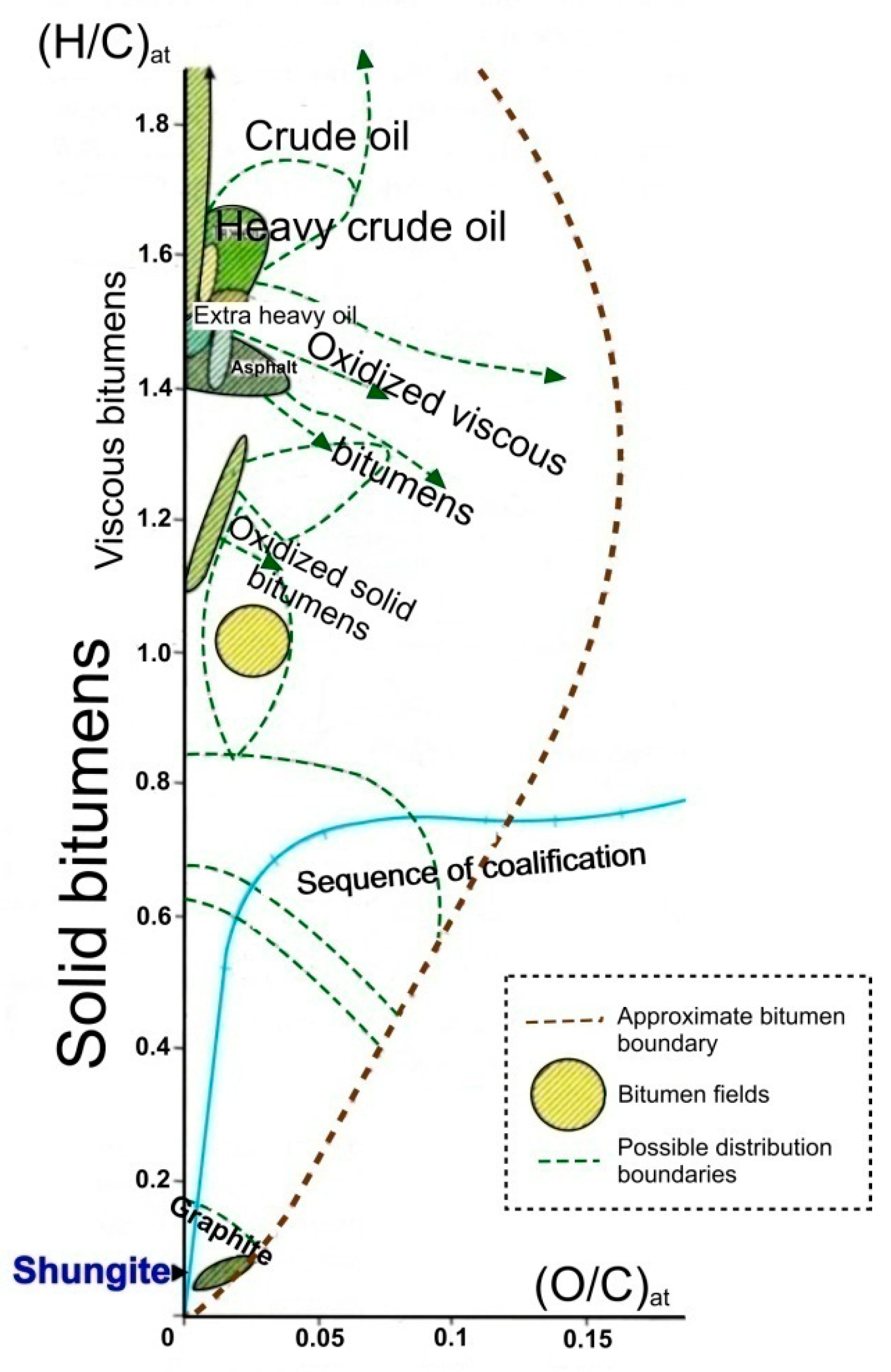
Figure 1. Van Crevelen diagram of carbonization (dehydrogenation) showing the alteration of H/C atomic ratios versus O/C. Dsp2C (represented by shungite) is limited to a narrow region close to the end member of pure carbon (adapted from [2]).
Dsp2C is often present in oil and gas basins and in ore deposits of hydrothermal origin [11][12][13]. The geological conditions for the formation of such carbon in petroleum and gas source formations are deep catagenesis, metamorphism, intrusive magmatism, and post-magmatic hydrothermal activity [14][15][16]. The occurrences are known in rocks of all ages, including the most ancient Precambrian paleobasins, more than 2 billion years old. The scale of occurrences of Dsp2C in the Earth’s crust varies over a very wide range. Dsp2C both fills micro-sized pores in rocks and forms multi-meter reservoir deposits and large veins tens and hundreds of meters long (Figure 2). The occurrences of Dsp2C have been found on all continents. The most fully characterized in the literature is the non-crystalline carbon of shungite occurrences in Karelia (Lake Onega region, Russia) [17][18]. Interest in shungite carbon increased after the first discovery of fullerenes of geological origin in it [19]. In addition to the shungite rocks of Karelia, significant occurrences with well-characterized structure and properties of Dsp2C (referred to in the geological and mineralogical literature as anthraxolites and pyrobitumen) are located in Bakyrchik (Kyzyl fault zone, Kazakhstan) [20][21][22], Mitov (Bohemian massif, Czech Republic) [23][24], Novaya Zemlya island (Russia) [25], Sichuan province (China) [26], the Sudbury Astroblem (Canada) [27][28][29], the Franceville Sedimentary Basin (Gabon) [30][31], the Michigan Formation (USA) [32][33], and many others.
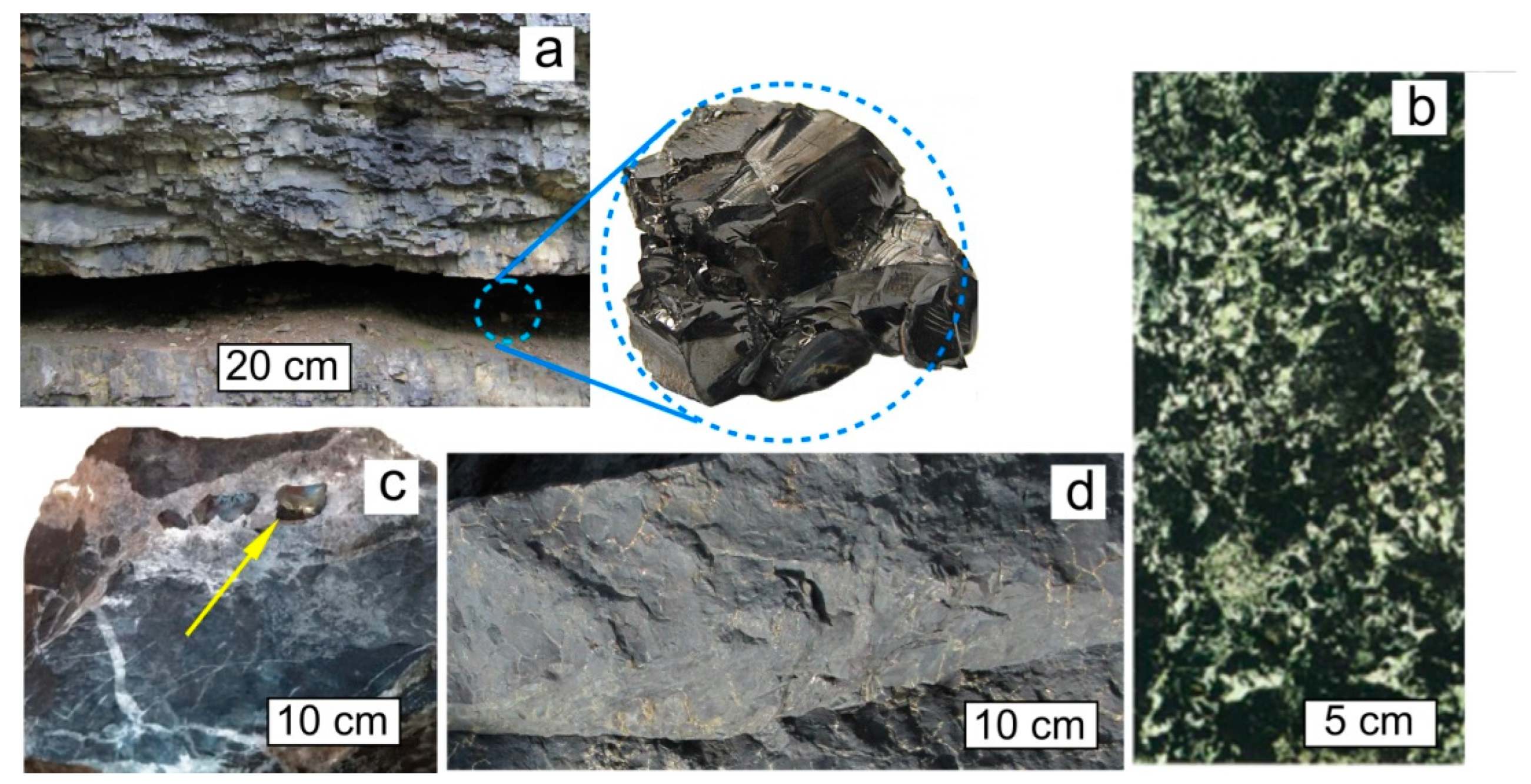
Figure 2. Typical occurrences of natural Dsp2C: shungite carbon vein (Shunga occurrence, Karelia), with a typical sample in the inset (a). Cluster form of inclusions of Dsp2C in the rock, Zazhogino occurrence, Karelia (b). Dsp2C isolations as grains (indicated by yellow arrow) in a calcite vein, occurrence Rucheynoye, Kozhim River, Subpolar Urals, Russia (c). Rock (quartzite) impregnated with Dsp2C, Maksovo occurrence, Karelia (d).
The formation of Dsp2C is associated with volcanic or high-temperature hydrothermal metamorphism of hydrocarbons in or near petroleum deposits. Dsp2C is a derivative of petroleum or substances similar to petroleum (for example, viscous bitumen) formed during the natural pyrolysis of kerogens under severe thermal and/or baric conditions, since their metamorphism occurs at depth. Additionally, the thermal impact of volcanic intrusions or their supply channels on bitumen occurrences in the surface layers of the Earth’s crust is possible. The precursors of Dsp2C (petroleum and viscous bitumen) mainly originate from lacustrine algae and marine microorganisms, for example, during local contact heating of sapropelic algae massifs by volcanic intrusions or hydrotherms. The organic matter of terrestrial plants, as a rule, is transformed to coal, which is not the object of consideration in the work. Graphitizable carbon is characterized by precursors enriched in hydrogen, while non-graphitizable carbon has precursors with a more complex composition, enriched primarily in oxygen and sulfur [34].
Physicochemical conditions for the formation of Dsp2C in nature are estimated from geological records. The lowest temperature stage of formation is the greenschist facies with a temperature range of 250–550 °C at a pressure of 1.5 to 4 kbar. In the hydrothermal process, the transformation occurs at a temperature of about 360 °C and a little higher. During volcanic contact metamorphism, the temperature of impact on hydrocarbon matter is the highest in the Earth’s crust. In the zone of contact between rocks and magma, an area of rock heating is formed, where the temperature reaches 500–900 °C. The maximum range of such metamorphism is 2–5 km. In rare cases, the formation of disordered sp2 carbon is accompanied by a local increase in pressure in the zones of tectonic faults [11]. This is conditioned by the fact that pressure accelerates graphitization, and under such conditions, the formation of well-crystallized graphite is more likely than Dsp2C [35][36][37].
3. Structural Characteristics and Models of Natural Disordered sp2 Carbon
The object of the consideration is Dsp2C, which makes its structural characteristics ambiguous. It does not graphitize during high-temperature (up to 2900 °C) treatment [38] under normal pressure conditions. The development of physicochemical methods allowed determining some structural features and chemical composition, but electron and X-ray amorphism still does not allow to unambiguously describe its structure. For example, at different times, the carbon of shungites was defined by researchers as weakly ordered graphite [39], amorphous carbon [4], natural metastable non-graphitic carbon [40], natural glassy carbon [41], and fullerene-like carbon in the group of non-graphitic natural carbonaceous substances [42][43]. In this section, the main models of the structure of natural Dsp2C are considered, primarily using shungite carbon as an example.
3.1. Molecular Structure
The basis of the molecular structure of natural Dsp2C is a graphene grid. The size and shape of these grids vary depending on the type of supramolecular structure to which the grid belongs. The following main supramolecular structures were found in natural Dsp2C: turbostratic stacks of graphene layers (grids), multilayer ribbons, fully enclosed multilayer globules, and partially closed multilayer cups (Figure 3).
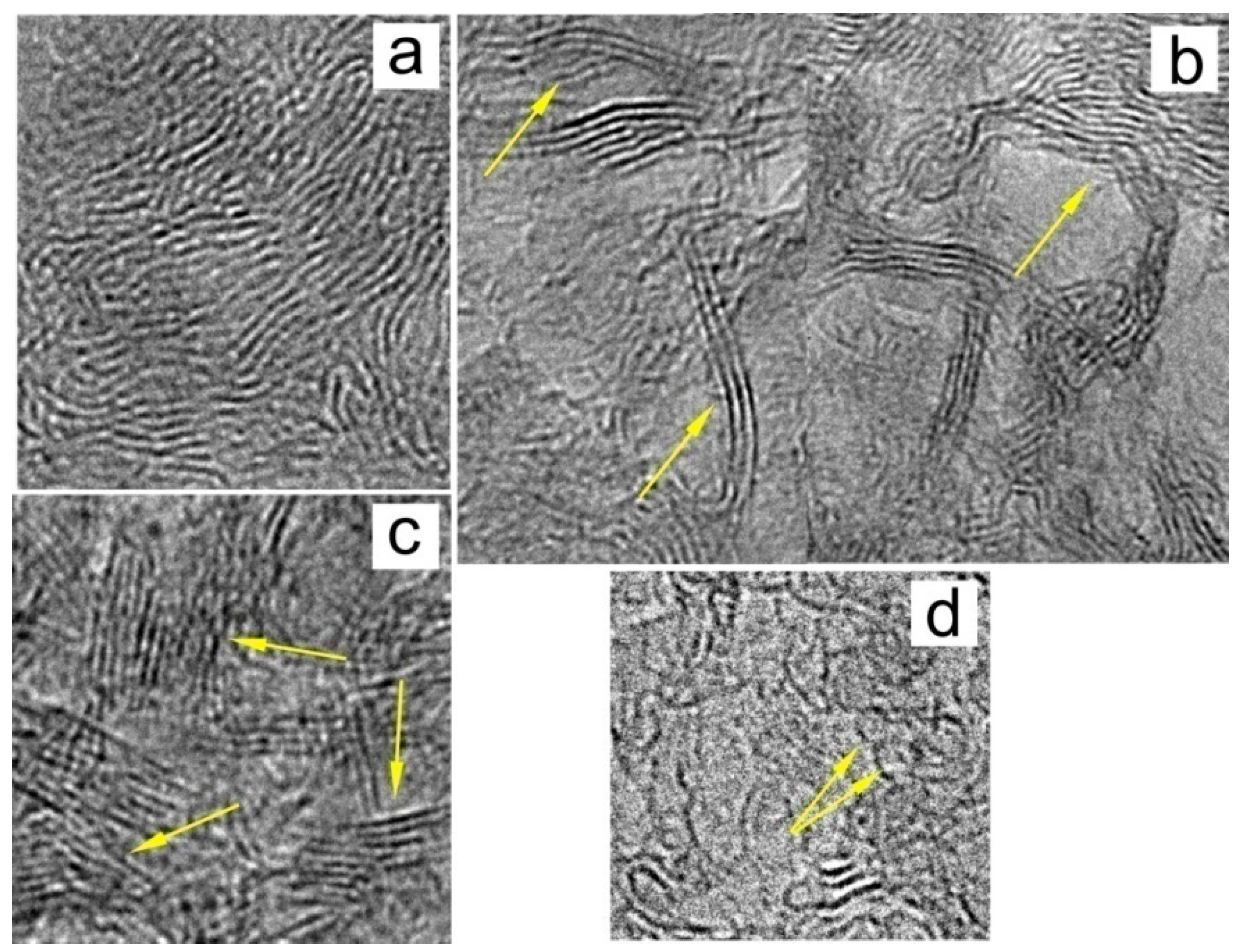
Figure 3. Basic structures of Dsp2C: (a) typical entangled structure, (b) ribbon structure, (c) stacks of graphene layers, and (d) fullerene-like single-layer and multilayer structures.
In stacks, grids are predominantly 1–7 nm in size, and interlayer (interplanar) distances range from 0.341 to 0.360 nm (according to Kovalevsky [42][44] and Aleshina and Fofanov [45]). This exceeds the interplanar distances characteristic of graphite (0.335 nm). The shape of grids 1–2 nm in size is predominantly flat and even; however, with a further increase in size, the number of curved and crumpled grids increases. There are defects in the subtraction and insertion of grids within the graphene packs. It is likely that such local distortions of various nature result in the deformation of the internal structure of the graphene grid. For example, according to Kovalevsky, the carbon layer in the graphene grid is deformed by the type of compression and tension in different directions, which leads to a decrease in the hexagonal symmetry of the graphene layer to trigonal [43] (Figure 4).
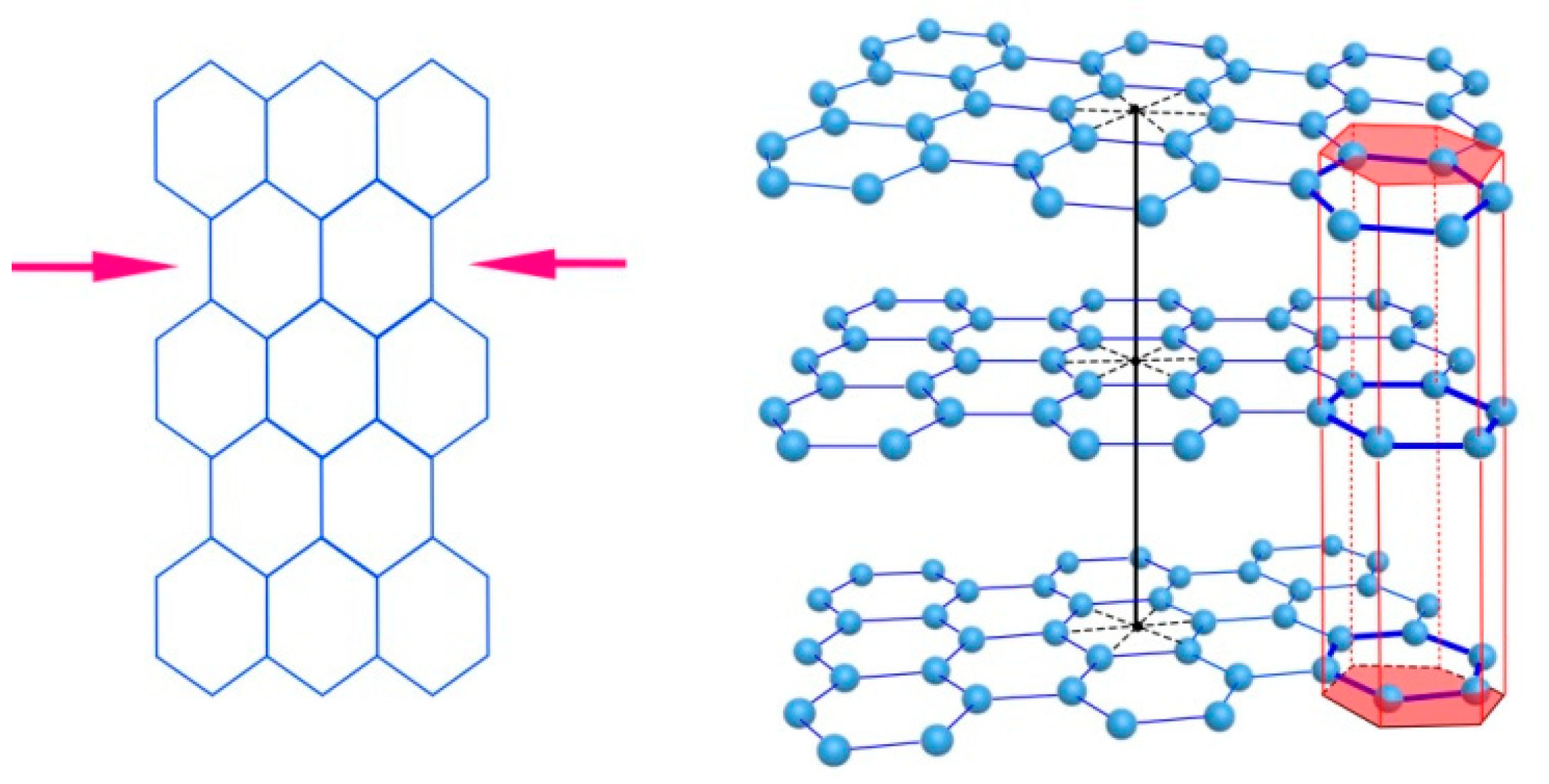
Figure 4. Deformation of a graphene layer (left) and displacement of flat graphene layers relative to each other in the stack (right).
In the stacks, the layers are turbostratically arranged. They are slightly deployed and (possibly) displaced relative to each other (Figure 4). As the reason for such an arrangement of layers, one can indicate the effect of edge functional groups. During the formation of carbon from the initial hydrocarbon substance, the structure of the graphene network condensed due to the destruction of the oxygen and hydrogen components. However, these functional groups (primarily oxygen groups) terminated the edges of graphene grids and prevented their further growth. Additionally, the van der Waals interaction of functional groups located in adjacent layers of packs “unfolded” the graphene layers relative to each other, preventing them from forming three-dimensionally ordered graphite nanocrystals. Such a pack can also be represented as an element of the supramolecular structure of Dsp2C, since it consists of graphene molecules linked by non-covalent bonds.
The calculation from X-ray diffraction curves allowed determining that the grids were either flat (in this case, they consisted of 280–300 atoms) or curved (consisted of 180–200 atoms), and formed packets of five to six layers, within which the grids are chaotically displaced and misoriented relative to each other [45]. Some nodes, both in flat and curved grids, are vacant (their share of the total number is 5–15%). The deformation of the graphene layer can also be associated with the presence of pentagonal or heptagonal ring structures in it. If the graphene layer simultaneously contains pentagonal and heptagonal ring structures, then the layer will be bent in different directions, i.e., corrugated. Similar structures have been found in addition to shungites in the anthraxolites from Novaya Zemlya, Kazakhstan, Mitov, and others.
In a series of works [46][47], shungite carbon is presented as a fractal multilevel structure. The authors consider fragments of reduced graphene oxide (RGO) with linear dimensions of ~1 nm as its main elements. Here, the structure of shungite carbon is based on nanosized RGOs, which, like their synthetic analogs [47][48], are formed as a result of a sequence of chemical transformations associated with the removal of oxygen-containing groups from the basal planes of graphene grids (Figure 5). The initial product for RGO formation was nanosized carbon fragments (lamellae). Simple oxygen-containing groups from the surrounding aqueous fluid acted as lamella oxidizers. The restoration of the lamellae took place under hydrothermal conditions for a long geological time, which ensured the occurrence of chemical reactions to their final stages. The difference between this graphene grid model and the work of Aleshina, Fofanova, and Kovalevsky lies primarily in the fact that in the model of Sheka, the graphene grid is assumed to be flat with a necklace of heteroatoms along the edges. The second structural level consists of five- to six-layer stacks of the indicated RGO fragment. Globules composed of these stacks, with linear dimensions of 3–6 nm, form the third structural level, and aggregates of globules, detected by scanning probe microscopy [49][50][51] and having sizes from 20 to 100 nm, form the final structural level.
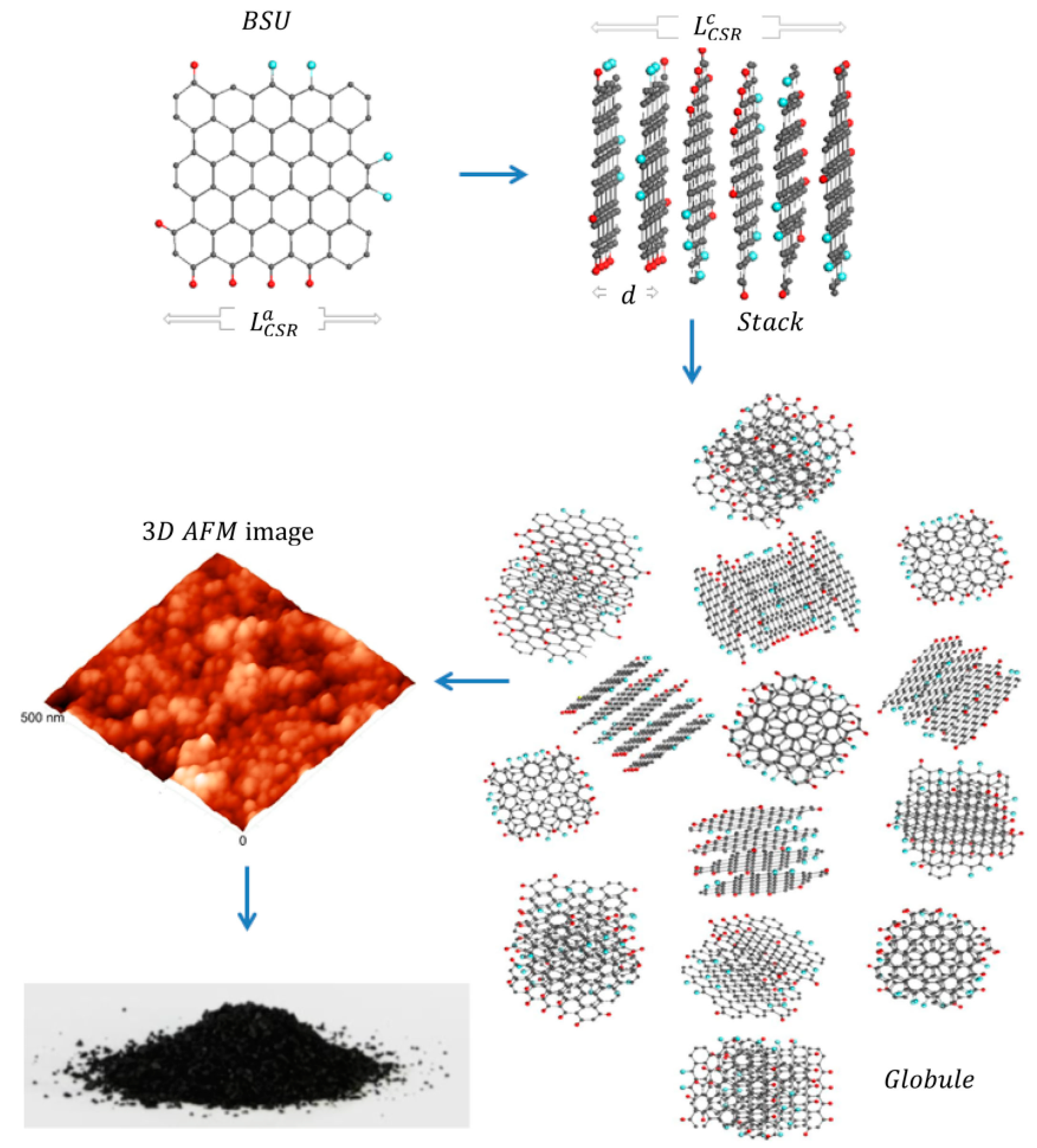
Figure 5. Scheme of the formation of a super-molecular globular structure of natural Dsp2C (from [52]) through the formation of a stack of graphene layers as basic structural units (BSU) with subsequent aggregation of stacks into a rounded particle (globule). The globules are shown in an atomic force microscope (AFM) image. Along the edges of graphene molecules are heteroatoms (hydrogen (red balls) and oxygen (blue balls)).
Such models are confirmed, in particular, in the data of high-resolution transmission electron microscopy (HRTEM) [42][48][53][54][55]. Modern high-resolution images of the structure of natural Dsp2C show a significant proportion of rectilinear bands up to several nanometers long. These bands are projections of the carbon atomic planes oriented almost parallel to the electron beam, which were referred in [48] to the basic nanosized RGO. Figure 6 shows that these planes are grouped into stacks. The distances between planes in stacks are 0.34–0.38 nm. Figure 6 clearly shows the grouping of atomic planes into stacks of 4–7 layers, which in the early works of Kovalevsky were interpreted as stacks of graphene layers [42]. Generally, in the shungite, the carbon layers as a rule are combined into stacks of 5–14 layers. Obviously, these stacks are misoriented relative to each other in the image plane. Due to the difference in the orientation of the stacks relative to the direction of the electron beam, some of them may not be visible under these measurement conditions. This hinders the estimation of the distribution density of such fragments; however, it seems to researchers that it is these piles that are the dominant structural element of Dsp2C in the size range of 1–10 nm.

Figure 6. Chaotically oriented stacks of graphene layers in shungite carbon (indicated by yellow arrow).
The Raman spectroscopy also specifies a similar structure of nanosized stacks as another very informative method to study the structure of Dsp2C. In the 21st century, Raman scattering has rapidly become the dominant method for testing carbon solids based on graphene. Two approaches have been developed to understand Raman scattering in such structures. The solid-state approach is formed based on phonon scattering in both perfect and defective crystals, while the molecular approach is based on the analysis of vibrations of free molecules (for a review, see [56]). The similarity of the spectra for defective and highly disordered graphite crystals, represented by the D, G, and 2D key bands, allowed using and improving the solid-state approach to characterize the sp2 carbon structure, including the nanoscale one, using the position, width, and intensity of these bands. The solid-state approach was also applied to Dsp2C. But, due to the structure disorderness and the small size of the graphene layers packs the correctness of this approach is weak in comparison the molecular approach to the Raman spectra of natural Dsp2C [57][58]. In general, despite the difference in theoretical foundations, the key result of the interpretation of Raman spectra in the framework of both approaches is the assessment of the structure of natural Dsp2C as a set of stacks of graphene layers with sizes of a few nanometers [55][57][58]. It should be noted that a reliable estimate of the packet sizes from Raman spectra at the current stage causes great difficulties for the objects of the study [57][58].
In [5][52], as a result of a comprehensive study of a wide range of objects using modern methods, natural Dsp2C is presented as an aggregate of nanosized stacks of graphene layers with edge impurities, such as hydrogen, oxygen, nitrogen, and sulfur, which are attached to the carbon core through chemical bonds. Models of the main structural units in the form of framework graphene oxyhydrides of nanometer size are proposed. The composition of the edge oxygen-containing groups allowed separating natural Dsp2C into disordered “C=O” (shungite carbon) and disordered “C=O–C–O” (anthraxolite carbon). This confirms the assumption about the chemical nature of shungite carbon as reduced graphene oxide. The radical nature of the basic structural units makes natural carbon a source of stable radicals.
Shungite carbon is also characterized by curved layers of different lengths covering the pores. A similar bowl-like model of the structure with carbon “cups” (as segments based on which fullerene-like structures are further formed) about 1 nm in size is confirmed by the results of solid-state 13C and 1H nuclear magnetic resonance spectroscopy [59].
3.2. Super-Molecular Structure
For a long time, the super-molecular structure of natural Dsp2C was not the focus of researchers. The interest of physicists and materials scientists in the super-molecular structure of Dsp2C drastically increased after the publication of fullerenes of geological origin found in Karelian shungites [18]. Earlier, Kovalevsky created a model where the fundamental element of shungite carbon is a fullerene-like globule. After publication [18], the Kovalevsky model for a long time became the dominant idea of the super-molecular structure of shungite carbon [60][61]. According to the model, a shungite globule is a spherical or ellipsoidal multilayer carbon formation about 10 nm in size, presumably with a pore inside (Figure 7). The main arguments in favor of the model are the presence of two types of pores (open and closed) in shungite carbon (see [44] and references therein), and the results of processing HRTEM images using the Cowley method [42].
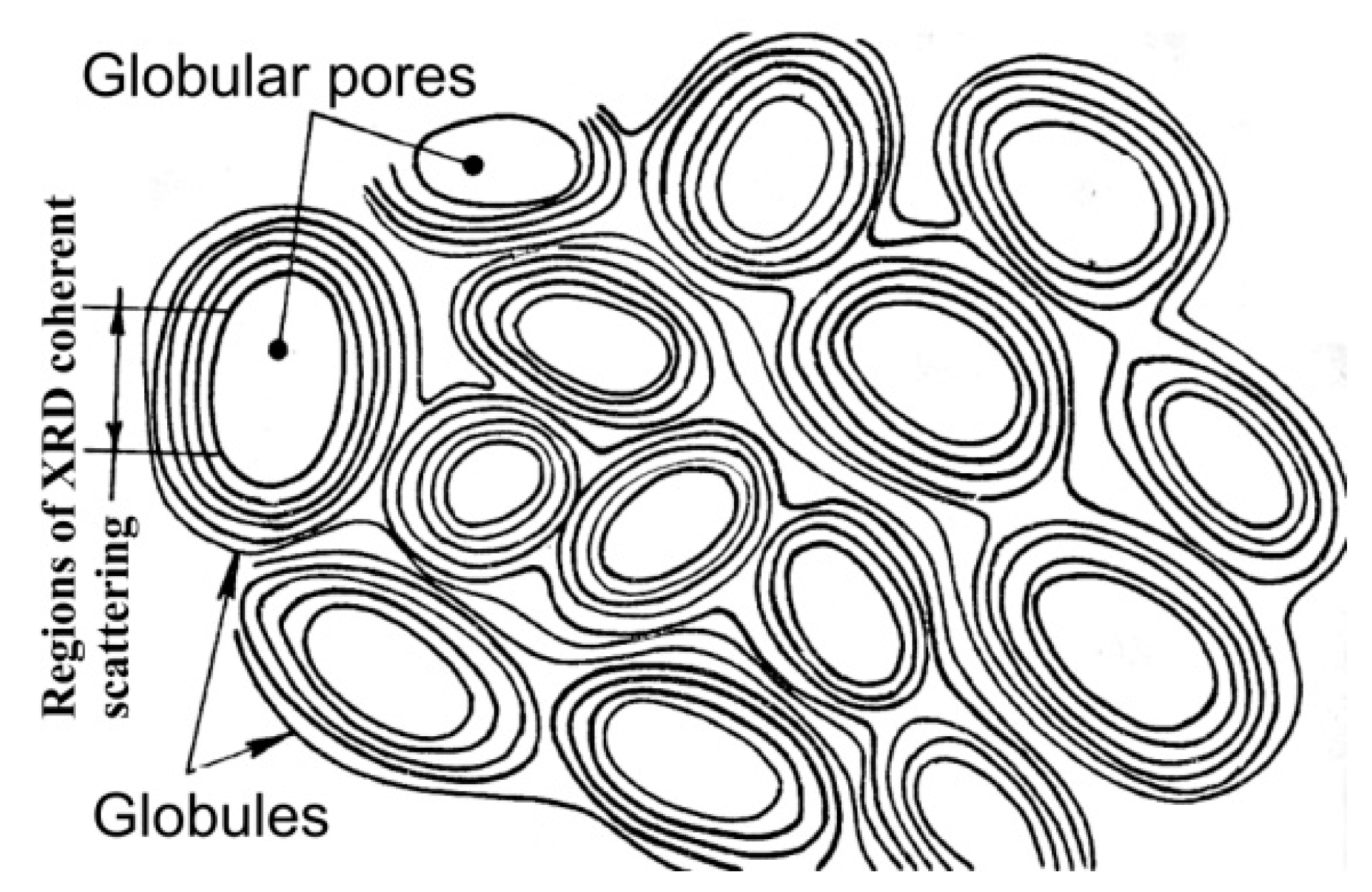
Figure 7. Physical model of shungite carbon. The figure is taken from [61].
A direct image of the globular structure of shungites was first obtained by scanning tunneling microscopy in [49]. Later, the globular structure of shungite carbon for all major deposits of Karelia and anthraxolites was studied in detail by scanning tunneling and atomic force microscopy [50][51]. Atomic force microscopy visualizes globules of a spherical or ellipsoidal shape, predominantly 20–70 nm in size. There is no regularity in the arrangement of globules; however, regularities of globule aggregation are distinguished [54] due to their grouping into chains (Maksovo, Perya). Similar structures are also characteristic of synthetic glassy carbon [62].
Ribbon-like structures are present in all studied shungites, as well as in most anthraxolites (Figure 3). Such a structure was found only at the beginning of its study using high-resolution transmission microscopy. It is difficult to trace the length and bends of the ribbons from 2D images, however, it can be said that the ribbons have a length of tens and (possibly) hundreds of nanometers and are tangled into rather complex configurations, and at the same time loose knots. Single-layer fullerene-like particles 1–2 nm in size are also often present in the structure of Dsp2C (Figure 3).
A reliable statistical analysis of the ratio of different structural forms of carbon is difficult due to the locality and selectivity of the high-resolution transmission microscopy method. Here, very limited areas are studied, not all structural fragments in which are in a reflective position, and therefore are not visible in the images. The authors of [48] attribute the curvature of primary RGO fragments to the presence of various mineral inclusions accompanying the formation of shungite, from micro–nano-sized particles of silica to nanoparticles of native metals in close proximity to them or in contact with them.
Thus, the complexity of the structure of disordered carbon does not at present allow building a universal model of the structure. This led to the selection of basic elements that formed the structure and determined the most significant properties. This approach was successfully used by Kovalevsky to describe shungite carbon as natural fullerene-like carbon. The globular structural component was singled out by him as the most significant. In [46][47], a flat graphene sheet about 1 nm in size, which is graphene oxide reduced in an aqueous medium, was proposed as the main element. These sheets form stacks, which are further folded into nanosized globules and larger particles. An analogy of the structure of natural Dsp2C is possible within the framework of the ribbon glassy carbon model.
In general, the molecular and super-molecular levels of natural Dsp2C are characterized by mixed structural forms (ribbons and turbostratic packages of graphene layers, multilayer rounded, and flattened globules) based on the graphene grids, which are partially present both in natural (kerogen, anthracite) and technical (glassy carbon, soot) materials. There is a wide range of sizes of structural elements, their shape, and types of defects. These features can be explained by the different origin of the hydrocarbon precursor, the duration and intensity of heating, the magnitude of the applied pressure, as well as a change in the mobility of heteroatoms during the formation process and their initial composition [11].
References
- Vieira, L.S. A review on the use of glassy carbon in advanced technological applications. Carbon 2022, 186, 282–302.
- Cornelius, C.D. Classification of Natural Bitumen: A Physical and Chemical Approach. In Exploration for Heavy Crude Oil and Natural Bitumen: AAPG Studies in Geology, 25; Meyer, R.F., Ed.; American Association of Petroleum Geologists: Tulsa, OK, USA, 1987.
- Oberlin, A. High-resolution TEM studies of carbonization and graphitization. In Chemistry and Physics of Carbon; Thrower, P.A., Ed.; Marcel Dekker: New York, NY, USA, 1989.
- Buseck, P.R.; Huang, B.J. Conversion of carbonaceous material to graphite during metamorphism. Geochim. Cosmochim. Acta 1985, 49, 2003–2016.
- Beyssac, O.; Rumble, D. Graphitic carbon: A ubiquitous, diverse, and useful geomaterial. Elements 2014, 10, 415–420.
- Golubev, Y.A.; Rozhkova, N.N.; Kabachkov, E.N.; Shul’ga, Y.M.; Natkaniec-Hołderna, K.; Natkaniec, I.; Antonets, I.V.; Makeev, B.A.; Popova, N.A.; Popova, V.A. sp2 amorphous carbons in view of multianalytical consideration: Normal, expected and new. J. Non-Cryst. Solids 2019, 524, 119608.
- Harris, P.J.F. New perspectives on the structure of graphitic carbons. Crit. Rev. Solid State Mater. Sci. 2005, 30, 235–253.
- Mélinon, P. Vitreous Carbon, Geometry and Topology: A Hollistic Approach. Nanomaterials 2021, 11, 1694.
- Uspensky, V.A.; Radchenko, O.A.; Glebovskaya, E.A. Basics of Genetic Classification of Bitumen; Nedra: Leningrad, Russia, 1964. (In Russian)
- Jakob, H. Nomenclature, Classification, Characterization and Genesis of Natural Solid Bitumen (Migrabitumen). In Bitumen in Ore Deposits; Parnell, J., Kucha, H., Landais, P., Eds.; Springer: Berlin/Heidelberg, Germany, 1993.
- Filippov, M.M. Anthraxolites; VNIGRI: Saint Petersburg, Russia, 2013. (In Russian)
- Filippov, M.M. Shungite-Bearing Rocks of the Onega Structure; Karelian Science Centre: Petrozavodsk, Russia, 2002. (In Russian)
- Filippov, M.M.; Cherevko, N.K.; Golubev, Y.A. Higher anthraxolites. Geol. Ore Dep. 2007, 49, 624–629.
- Melezhik, V.A.; Fallick, A.E.; Fillipov, M.M.; Larsen, O. Karelian shungite—An indication of 2.0-Ga-old metamorphosed oil-shale and generation of petroleum: Geology, lithology and geochemistry. Earth Sci. Rev. 1999, 47, 1–40.
- Pen’kov, V.F. Genetic Mineralogy of Carbonaceous Substances; Nedra: Moscow, Russia, 1996.
- Mossman, D.J. Carbonaceous Substances in Mineral Deposits: Implications of Geochemical Explorations. J. Geochem. Expl. 1999, 66, 241–247.
- Buseck, P.R.; Galdobina, L.P.; Kovalevski, V.V.; Rozhkova, N.N. Shungites: The C-rich rocks of Karelia, Russia. Can. Mineral. 1997, 35, 1363–1378.
- Melezhik, V.A.; Filippov, M.M.; Romashkin, A.E. A giant palaeoproterozoic deposit of shungite in NW Russia: Genesis and practical applications. Ore Geol. Rev. 2004, 24, 135–154.
- Buseck, P.R.; Tsipursky, S.J.; Hettich, R. Fullerenes from the Geological Environment. Science 1992, 257, 215–217.
- Glebashev, S.G.; Ignatiev, S.V.; Kovyazin, A.N. Formation and placement of shungite rocks in the Kyzyl zone (East Kazakhstan). Sov. Geol. 1989, 1, 33–42.
- Golubev, E.A.; Glebashev, S.G.; Ignatiev, S.V.; Filippov, V.N. Supramolecular structure of anthraxolite from the Bakyrchik deposit, East Kazakhstan. Vestn. IG Komi SC UB RAS 2006, 4, 4–7.
- Baigulbaeva, M.M.; Ongarbaev, E.K.; Tileuberdi, E.; Zhambolova, A.B.; Zhumakhan, K. Influence of mechanochemical activation on the composition, properties and structure of shungite rocks. Combust. Plasma Chem. 2021, 19, 149–156.
- Jehlička, J.; Rouzaud, J.N. Structural and micro textural features of solid bitumens from pillow lavas from Mitov (Barrandian Neoproterozoic, Bohemian Massif). Věstn. CGU 2000, 75, 297–306.
- Jehlička, J.; Svatoš, A.; Frank, O.; Uhlík, F. Evidence for fullerenes in solid bitumen from pillow lavas of Proterozoic age from Mítov (Bohemian Massif, Czech Republic). Geochim. Cosmochim. Acta 2003, 67, 1495–1506.
- Silaev, V.I.; Ilchenko, V.O.; Lyutoev, V.P.; Filippov, V.N.; Golubev, E.A.; Kovaleva, O.V. Authic Pseudomineralization in Anthraxolite. Problems of Geology and Mineralogy; Geoprint: Syktyvkar, Russia, 2006.
- Xiao, X.M.; Wang, F.; Wilkins, R.W.T.; Song, Z.G. Origin and gas potential of pyrobitumen in the upper proterozoic strata from the Middle Paleo—Uplift of the Sichuan basin, China. Int. J. Coal Geol. 2007, 70, 264–276.
- Thomson, J.E. On the origin of algal-like forms and carbon in the Sudbery basin, Ontario. Trans. R. Soc. Can. 1960, 54, 65–75.
- Youg, G.M. Tectono-sedimentary history of early proterozoic rocks of the northern Great Lakes region. Geol. Soc. Amer. 1983, 160, 15–32.
- Pye, E.G.; Naldrett, A.J.; Giblin, P.E.; Mineralization in the Whitewater group. The geology and ore deposits of the Sudbery structure Ontario geological survey. Ont. Geol. Surv. 1984, 1, 219–232.
- Mossman, D.J. Hydrocarbon habitat of the paleoproterozoic Franceville series, republic of Gabon. Energy Sources 2001, 23, 45–53.
- Mossman, D.J.; Nagy, B. Solid bitumens: An assessment of their characteristic, genesis, and role in geological processes. Terra Nova 1996, 8, 114–128.
- Tyler, S.A.; Barghoorn, E.S.; Barrett, L. Anthracitic coal from Precambrian upper huronian black shale of the Iron River district, northern Michigan. Geol. Soc. Am. Bull. 1957, 68, 1293–1304.
- Mancuso, J.I.; Kneller, W.A.; Quick, I.C. Precambrian vein pyrobitumen: Evidence for petroleum generation and migration 2 Ga ago. Precambrian Res. 1989, 44, 137–146.
- Buseck, P.R.; Beyssac, O. From Organic Matter to Graphite: Graphitization. Elements 2014, 10, 421–426.
- Bonijoly, M.; Oberlin, M.; Oberlin, A. A possible mechanism for natural graphite formation. Int. J. Coal Geol. 1982, 1, 283–312.
- Bustin, R.M.; Rouzaud, J.-N.; Ross, V. Natural graphitization of anthracite: Experimental considerations. Carbon 1995, 33, 679–691.
- Beyssac, O.; Brunet, F.; Petitet, J.; Goffé, B.; Rouzaud, J.N. Experimental study of the microtextural and structural transformations of carbonaceous materials under pressure and temperature. Eur. J. Mineral. 2003, 15, 937–951.
- Khavari-Khorasani, G.; Murchison, D.G. The nature of Karelian shungite. Chem. Geol. 1979, 26, 165–182.
- Kviecinska, B. Investigations of shungite. Bull. Pol. Acad. Sci. Chem. 1968, 16, 61–65.
- Kalinin, Y.K.; Usenbaev, K.U.; Kovalevskii, V.V. Shungite Structure as a Function of the Conditions of Its Formation. In Mineralogy and Geochemistry of the Precambrian of Karelia; IG Kar SC RAS: Petrozavodsk, Russia, 1979. (In Russian)
- Jehlička, J.; Rouzaud, J.-N. Glass-like carbon: New type of natural carbonaceous matter from Precambrian rocks. Carbon 1992, 30, 1133–1134.
- Kovalevski, V.V.; Buseck, P.R.; Cowley, J.M. Comparison of carbon in shungite rocks to other natural carbons: An X-ray and TEM study. Carbon 2001, 39, 243–256.
- Kovalevski, V.V. Shungite or higher anthraxolite. Zap. RMO 2009, 5, 97–105.
- Kovalevski, V.V. Structure of shungite carbon. Russ. J. Inorg. Chem. 1994, 39, 28–32.
- Aleshina, L.A.; Kuzmina, I.O.; Fofanov, A.D.; Shivrin, O.N. X-ray Determination of the Structural Characteristics of the Short-Range Order in Shungite-I. In Condensed Non-Crystalline State of the Earth’s Crust; Nauka: Saint Petersburg, Russia, 1995. (In Russian)
- Sheka, E.F.; Rozhkova, N.N. Shungite as loosely packed fractal nets of graphene-based quantum dots. Int. J. Smart Nano Mat. 2014, 5, 1–16.
- Sheka, E.F.; Rozhkova, N.N.; Holderna-Natkaniec, K.; Natkaniec, I. Nanosystems. Phys. Chem. Math. 2014, 5, 659–672.
- Sheka, E.F.; Golubev, E.A. Technical Graphene (Reduced Graphene Oxide) and Its Natural Analog (Schungite). Tech. Phys. 2016, 61, 1032–1038.
- Yushkin, N.P. Globular supramolecular structure of shungites: Scanning tunneling microscopy data. Dokl. Akad. Nauk. 1994, 337, 800.
- Golubev, Y.A.; Kovaleva, O.V.; Yushkin, N.P. Observations and morphological analysis of supermolecular structure of natural bitumens by atomic force microscopy. Fuel 2008, 87, 32–38.
- Golubev, Y.A. Globular structure of higher anthraxolites according to data of scanning probe microscopy. Dokl. Earth Sci. 2009, 425A, 429–431.
- Sheka, E.F.; Golubev, Y.A.; Popova, N.A. Amorphous state of sp2 solid carbon. Fuller. Nanotub. Carbon Nanostructures 2021, 29, 107–113.
- Jehlička, J.; Rouzaud, J.N. Transmission electron microscopy of carbonaceous matter in precambrian shungite from Karelia. In Bitumens in Ore Deposits; Springer: Berlin/Heidelberg, Germany, 1993.
- Kovalevski, S.V.; Moshnikov, I.A. TEM study of structure of graphene layers in shungite carbon. Nanosyst. Phys. Chem. Math. 2016, 7, 210–213.
- Golubev, Y.A.; Isaenko, S.I.; Prikhodko, A.S.; Borgardt, N.I.; Suvorova, E.I. Raman spectroscopic study of natural nanostructured carbon materials: Shungite vs. anthraxolite. Eur. J. Mineral. 2016, 28, 545–554.
- Merlen, A.; Buijnsters, J.G.; Pardanaud, C. A guide to and review of the use of multiwavelength Raman spectroscopy for characterizing defective aromatic carbon solids: From graphene to amorphous carbons. Coatings 2017, 7, 153.
- Schuepfer, D.B.; Badaczewski, F.; Guerra-Castro, J.M.; Hofmann, D.M.; Heiliger, C.; Smarsly, B.; Klar, P.J. Assessing the structural properties of graphitic and non-graphitic carbons by Raman spectroscopy. Carbon 2020, 161, 359–372.
- Sheka, E.F.; Golubev, Y.A.; Popova, N.A. Graphene domain signature of Raman spectra of sp2 amorphous carbons. Nanomaterials 2020, 10, 2021.
- Rozhkova, N.N. Shungite Nanocarbon; Karelian Scientific Center of the Russian Academy of Sciences: Petrozavodsk, Russia, 2011.
- Kovalevski, V.V.; Rozhkova, N.N.; Zaidenberg, A.Z.; Yermolin, A.P. Fullerene-like structures in shungite and their physical properties. Mol. Mater. 1994, 4, 77–80.
- Filippov, M.M.; Golubev, A.I. (Eds.) Organic matter of shungite-bearing rocks of Karelia; Karelia: Petrozavodsk, Russia, 1994; 208p.
- Shumilova, T.G.; Akai, J.; Golubev, Y.A. Electron microscopy investigations of glassy-like carbon. In Electron Crystallography. Novel Approaches for Structure Determination of Nanosized Materials; Weirich, T.E., Lábár, J.L., Zou, X., Eds.; Springer: Dordrecht, The Netherlands, 2006; pp. 523–526.
More
Information
Contributors
MDPI registered users' name will be linked to their SciProfiles pages. To register with us, please refer to https://encyclopedia.pub/register
:
View Times:
858
Revisions:
2 times
(View History)
Update Date:
18 Nov 2022
Notice
You are not a member of the advisory board for this topic. If you want to update advisory board member profile, please contact office@encyclopedia.pub.
OK
Confirm
Only members of the Encyclopedia advisory board for this topic are allowed to note entries. Would you like to become an advisory board member of the Encyclopedia?
Yes
No
${ textCharacter }/${ maxCharacter }
Submit
Cancel
Back
Comments
${ item }
|
More
No more~
There is no comment~
${ textCharacter }/${ maxCharacter }
Submit
Cancel
${ selectedItem.replyTextCharacter }/${ selectedItem.replyMaxCharacter }
Submit
Cancel
Confirm
Are you sure to Delete?
Yes
No




